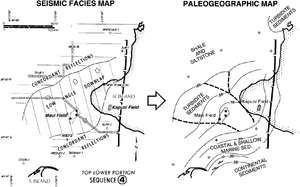Difference between revisions of "Mapping paleogeography"
Jump to navigation
Jump to search

Cwhitehurst (talk | contribs) |
FWhitehurst (talk | contribs) |
||
| Line 19: | Line 19: | ||
The table below outlines a procedure for making paleogeographic maps. | The table below outlines a procedure for making paleogeographic maps. | ||
| − | # With objectives in mind, choose intervals to map. Is the target within one [[depositional sequence]]? Is the target the entire section? | + | # With objectives in mind, choose intervals to map. Is the target within one [[Depositional sequence identification|depositional sequence]]? Is the target the entire section? |
# Choose the level of detail. Do you need to map the paleogeography at the level of a depositional sequence or a [[Systems tracts and trap types|systems tract]]? | # Choose the level of detail. Do you need to map the paleogeography at the level of a depositional sequence or a [[Systems tracts and trap types|systems tract]]? | ||
# Construct paleogeographic maps using all available information. | # Construct paleogeographic maps using all available information. | ||
Revision as of 21:01, 22 October 2014
| Exploring for Oil and Gas Traps | |

| |
| Series | Treatise in Petroleum Geology |
|---|---|
| Part | Predicting the occurrence of oil and gas traps |
| Chapter | Exploring for stratigraphic traps |
| Author | John C. Dolson, Mike S. Bahorich, Rick C. Tobin, Edward A. Beaumont, Louis J. Terlikoski, Michael L. Hendricks |
| Link | Web page |
| Store | AAPG Store |
Paleogeographic maps are the end product of the sequence stratigraphic analysis. Favorable sites for deposition of reservoir, seal, and source rocks can be ascertained from paleogeographic maps.
Procedure
The table below outlines a procedure for making paleogeographic maps.
- With objectives in mind, choose intervals to map. Is the target within one depositional sequence? Is the target the entire section?
- Choose the level of detail. Do you need to map the paleogeography at the level of a depositional sequence or a systems tract?
- Construct paleogeographic maps using all available information.
Example

Figure 1 Seismic facies map and corresponding paleogeographic map of the Middle Miocene Taranaki basin, offshore western New Zealand. From Bally;[1] courtesy AAPG.
Figure 1 is a seismic facies map and the corresponding paleogeographic map of the Middle Miocene Taranaki basin, offshore western New Zealand. The paleogeographic map depicts lithofacies and thicknesses in two-way time.
See also
- Basin-fill and trap analysis
- Procedure for basin-fill analysis
- Mapping unconformities
- Analyzing depositional sequences for traps
References
- ↑ Bally, A. W., ed., 1987, Atlas of Seismic Stratigraphy: AAPG Studies in Geology 27, vol. 1, 124 p.